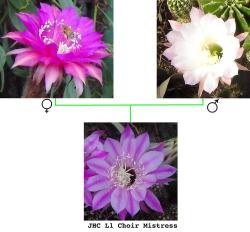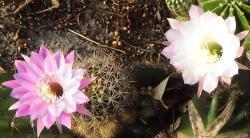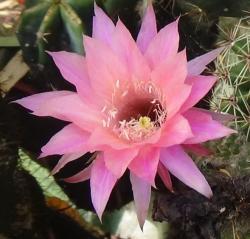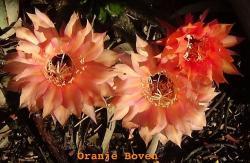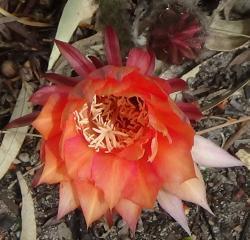@ausrprned
Simple Mendelian genetics are not usually very simple in the real world. In a lab or in special circumstances they can be relatively simple but in a cultivated/domesticated plant whose breeding population may have been formed from crosses between different species and sometimes between many different species they can be very complex.
One of the first things we would need to look at was how did the different flower colours originate in Echinopsis. As one simple example, if we were working within a single natural species we might find that a white flowered plant appeared after many years of crosses within a uniform population of a different flower colour. So, for example, all plants of a species Echinopsis might have pink coloured flowers and then a single white flowered seedling appeared in a batch of normal pink flowered seedlings. We could reasonably assume that the white flowered individual was a mutant and we could study the inheritance of the white flowers. It would be reasonable to expect their inheritance to be simple - either recessive or dominant and due to the mutation of a single gene.
On the other hand we might find that within that species not all individuals had the same pink flowers. Some individuals might have darker pink flowers and some might have lighter pink flowers. Say we only crossed the lighter pink flowered individuals with each other and only saved the lightest pink flowered seedlings from the crosses. After a few generations of repeatedly using only the lightest pinks as parents and only keeping seedlings that were lighter than their parents we would end up with more or less white flowered plants. It would be reasonable to assume that the inheritance of white would not be simple. It would not be caused by a single mutation in one gene but would likely be caused by natural genetic variation in many genes. Some of those genes would have a larger effect on the white flower colour and other genes would have a smaller effect. There could be 30 or 60 or even more different genes involved in producing the white flower colour.
In any species white (or any other colour) flowers could be caused by either mechanism or by both mechanisms.
In any natural species, if we look at the flower colour of different individuals we usually find that the flower colours are not identical. Natural genetic variation affects most characteristics in most plants and usually many different genes are involved in any given characteristic. In some species there are individuals that differ drastically in flower colour. In those species those different flower colours may be inherited simply. We describe such species as normally genetically polymorphic for flower colour. The different flower colours in those species play some role in the biology of the species.
Typically, flower colour involves at least 30-40 genes. That is what we know about the anthocyanin pigment flower colours and the carotenoid pigment flower colours. Unfortunately Echinopsis have a different flower colour system. Their flower colours are caused by betalain pigments. Much less is known about the genetics of betalain pigments.
In your particular cross the results of just four seedlings indicates that the genetics are not simple. If the flower colour of each parent was caused by just one gene and the parents were "pure breeding" (meaning homozygous) then their seedlings would all have one and the same flower colour. If the white flowered pollen parent was homozygous and the seed parent was heterozygous then their seedlings would have two different flower colours in more or less equal proportions. With four seedlings showing three different flower colours the reasonable conclusion is that two or more different genes are involved. Or that many genes are involved. To try to understand the inheritance of flower colour it is best to start with parents that are homozygous or "true breeding". That means if the seed parent was self-pollinated all its seedlings would have the same flower colour as their parent. The same thing would be true if the pollen parent was homozygous - all its seedlings from self-pollinations would have the same flower colour as their parent.
Is anything known about the inheritance of flower colour in Echinopsis? Do Echinopsis enthusiasts publish photos of the parents and seedlings of their crosses anywhere? Are breeding results published anywhere?
To get even a preliminary understanding of the inheritance of flower colour in Echinopsis, crosses would usually need to produce dozens, if not tens of dozens of flowered seedlings.
